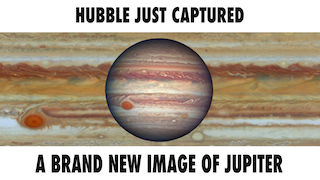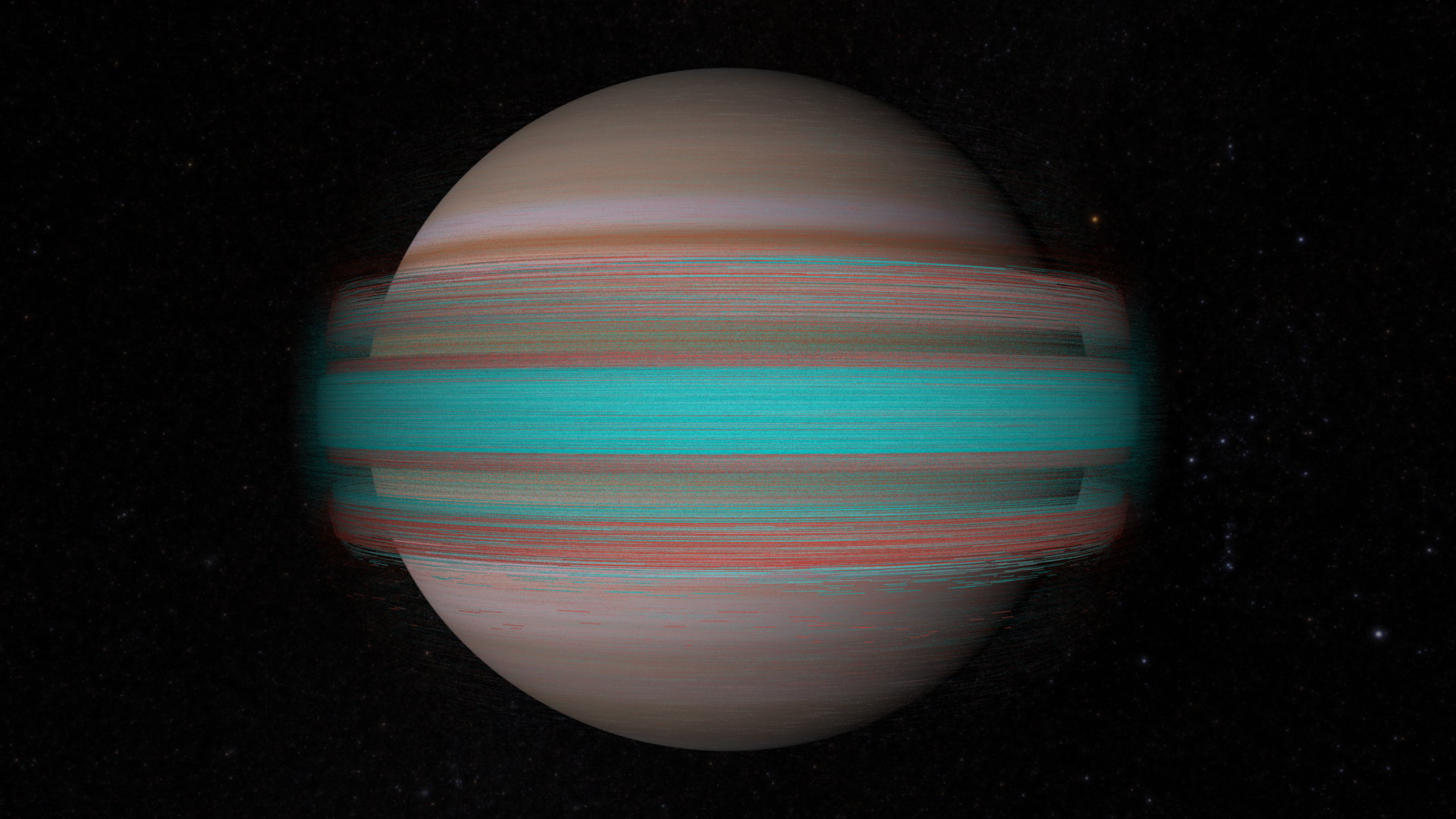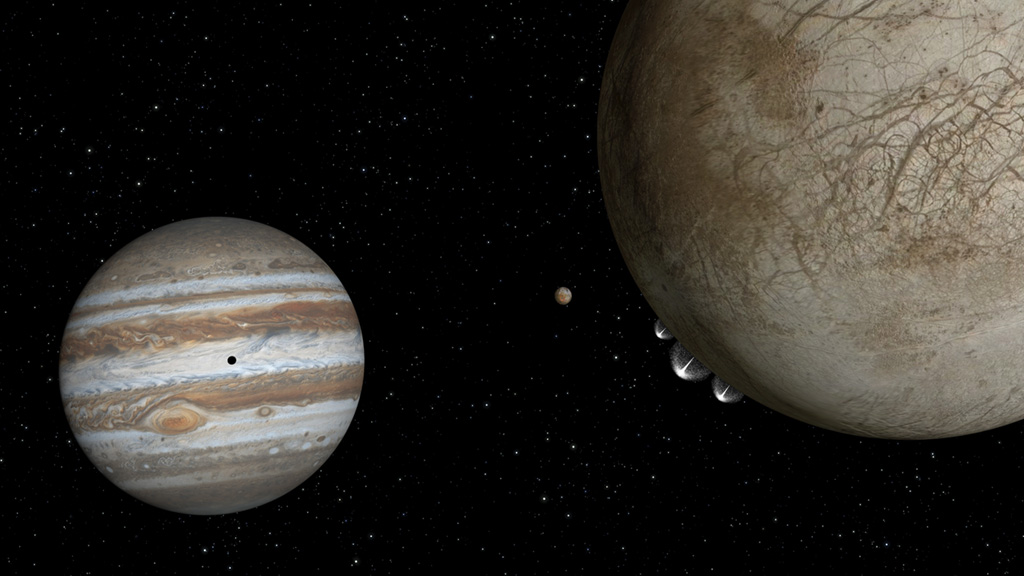Hubble Directly Images Possible Plumes on Europa
NASA's Hubble Space Telescope took direct ultraviolet images of the icy moon Europa transiting across the disk of Jupiter. Out of ten observations, Hubble saw what may be water vapor plumes on three of the images. This adds another piece of supporting evidence to the existence of water vapor plumes on Europa - Hubble also detected spectroscopic signatures of water vapor in 2012. The existence of water vapor plumes could provide NASA's Europa flyby mission the opportunity to study the conditions and habitability of Europa's subsurface ocean.
Read the full nasa.gov story here: http://www.nasa.gov/press-release/nasa-s-hubble-spots-possible-water-plumes-erupting-on-jupiters-moon-europa
Read the full science paper here: http://hubblesite.org/pubinfo/pdf/2016/33/pdf.pdf
Full details on the images can be found on HubbleSite.org: http://hubblesite.org/newscenter/archive/releases/2016/33/
Additional Resources:
JPL's "Europa: Tempting Target for Future Exploration" video file is downloadable here: https://vimeo.com/118505538
Read the Dec 2013 press release about Hubble's previous observations of Europa here: http://www.nasa.gov/content/goddard/hubble-europa-water-vapor
Web Video
Music credit: "Next Generation" by Enrico Cacace [BMI]; Atmosphere Music Ltd PRS; Volta Music; Killer Tracks Production Music
Watch this video on the NASA Goddard YouTube channel.
30-Second Social Media Video
Music credit: "Next Generation" by Enrico Cacace [BMI]; Atmosphere Music Ltd PRS; Volta Music; Killer Tracks Production Music
Animation of Plumes on Europa
This is an artist's concept of the moon Europa, at right, with water-ice plumes erupting from its limb at the 7 o'clock position. In the background is Jupiter's orange, volcanic moon Io. Io's shadow appears in the center of Jupiter's face, left.
Credit: NASA, ESA, and G. Bacon (STScI)

Photo Composite of Suspected Water Plumes on Europa (Annotated)
This composite image includes data from Hubble’s Space Telescope Imaging Spectrograph, which shows suspected plumes of water vapor erupting at the 7 o'clock position off the limb of Jupiter's moon Europa. The image of Europa, superimposed on the Hubble data, is assembled from data from the Galileo and Voyager missions.
Credit: NASA, ESA, W. Sparks (STScI), the USGS Astrogeology Science Center, and Z. Levay (STScI)

Photo Composite of Suspected Water Plumes on Europa - Non-Annotated
This composite image shows suspected plumes of water vapor erupting at the 7 o'clock position off the limb of Jupiter's moon Europa. The plumes, photographed by NASA's Hubble's Space Telescope Imaging Spectrograph, were seen in silhouette as the moon passed in front of Jupiter. Hubble's ultraviolet sensitivity allowed for the features, rising over 100 miles above Europa's icy surface, to be discerned. The water is believed to come from a subsurface ocean on Europa. The Hubble data were taken on January 26, 2014. The image of Europa, superimposed on the Hubble data, is assembled from data from the Galileo and Voyager missions.
Credit: NASA, ESA, W. Sparks (STScI), and the USGS Astrogeology Science Center

Europa Transiting Geometry
This diagram shows how the plumes on Europa are seen in silhouette as the moon moves across the face of Jupiter. Europa makes a complete orbit of Jupiter in just 3.5 Earth days.
Credit: NASA, ESA, and A. Feild (STScI)

GIF - Europa Transiting Jupiter
This video is a time-lapse sequence of Hubble Space Telescope images of the moon Europa as it moved across the face of Jupiter over the course of 19 minutes. Europa is at the bottom center on Jupiter's disk, with the Great Red Spot to the left and Europa's shadow to its right. The video was created by combining six snapshots taken in ultraviolet light with Hubble's Wide Field Camera 3.
Credit: NASA, ESA, W. Sparks and Zolt Levay (STScI)
For More Information
Credits
Please give credit for this item to:
NASA's Goddard Space Flight Center
-
Producer
- Katrina Jackson (USRA)
-
Editor
- Katrina Jackson (USRA)
-
Host
- Katrina Jackson (USRA)
-
Animator
- Greg Bacon (STScI/Aura)
Release date
This page was originally published on Monday, September 26, 2016.
This page was last updated on Wednesday, May 3, 2023 at 1:48 PM EDT.


![Music credit: "Street Dancer" by Donn Wilkerson [BMI] and Lance Sumner [BMI]; Killer Tracks BMI; Killer Tracks Production MusicWatch this video on the NASA Goddard YouTube channel.](/vis/a010000/a012500/a012585/Hubble_Europa_04-2017_thumbnail.png)
![Music credit: "Triangulate" by Gianluigi Gallo [PRS]; El Murmullo Sarao SGAE, Universal Sarao SGAE; SaraoMusic; Killer Tracks Production MusicWatch this video on the NASA Goddard YouTube channel.](/vis/a010000/a012500/a012570/Hubble_Jupiter_Opposition_thumbnail.png)
